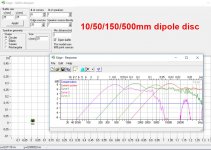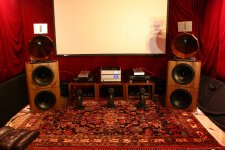That's not quite right. I think your mental image of the "dreaded considerable front-to-back cancellation" gives you much grief. Let me point out some aspects that may make you better understand why the situation is not so bad.
The amount of front-to-back cancellation IS frequency dependent (ignoring walls and boundaries for a moment). In fact at some frequency the cancellation actually becomes "superposition" meaning that the front-to-back waves are 100% IN PHASE and add to +6dB. This happens at the dipole peak. Here the dipole is actually radiating MORE POWER than a single monopole of the same driver cone area AND the on axis SPL is +6dB. It is only when you start to slide down from there in frequency that you enter the dreaded "cancellation" regime where the frequency response (assuming infinite driver bandwidth) reaches 6dB/octave. It is noteworthy that (by theory) you have to go down to 0.17*v/D Hertz (v=345m/s, D=dipole front-to-back separation distance in m) before the on-axis SPL of the dipole drops back to the monopole SPL. It's about one third of the dipole frequency. If size the dipole so that you use it from the peak down, you will maximize the SPL capabilities and not suffer from excessive front-to-back cancellation. That's it in a nutshell. If you take a look at my example H-frame earlier in this thread you can see that the dipole SPL was only down 3dB on axis WRT monopole at 40Hz. I would not call that 'considerable".
It's only when the front-to-back pathlength is short that the dipole peak is high in frequency. If you also try to operate this driver too far below the dipole peak it will struggle to overcome all the cancellation. This is why some dipole systems sound "thin" in my opinion. The practical lower limit is around 80-100Hz. Below this you must start to make D larger.
Either you are willfully ignorant of the transient response resulting a bass reflex loudspeaker compared to a driver in free air, or you don't know what you are talking about. There is no escaping it, no matter how "properly designed" is the BR system. It has a sharper ultimate rolloff at the low end of the passband, and this causes poor transient response. It's physics and the effect it is worse the sharper the "knee" around the tuning frequency.
On the other hand, a low Q (e.g. Q=0.5-0.7) driver in free air, or a baffle, or even an H-frame, will have exactly a second order response with that Q. Look it up. It's very clean. Also, there are no cabinet resonances and no port resonances, either. For these reasons I would have to say in relation to a BR a dipole is way out in front in terms of potential sound quality.
With this part I could not agree less.
Yes, it is "my thing" and a thing for others too. We're happy to continue to enjoy it, thanks. And you can continue to enjoy your BR systems. They are probably as good as they can be designed and they seem to have you convinced that is the way to go. To each their own.
I think you have made your point and stated your opinion clear enough. You think dipole/OB systems are inferior and incapable and BR is awesome. Do you have anything else to add, perhaps some technical argument to support your claim, or are you just going to keep coming back to your personal opinion again and again?
In a simple open baffle, the roll-off occurs at 6db/oct, set by the average width of the baffle. Below driver resonance, the roll-off increases to 18db/octave. Look it up.
My opinion is that OB baffle bass is erroneously touted as superior, while it really isn't. It's just a different way of doing things, with all the associated compromises that any type of bass systems has: compromises, but of a different nature.
Consider this, if OB bass was all that great, there would be a far greater number of commercial manufacturers using this scheme. But there aren't.
You seem agitated that another person may have a different opinion, than your own. Well, at least you didn't call me "textbook obsessed".
I am not an expert but I saw this article a few years ago on another thread and I must admit it now makes perfect sense to me.... after reading about 10 times!
Any form of delayed resonance loading is fundamentally flawed, fact.
When it comes to "fooling the ear" the vast majority of home audio loudspeakers, commercial loudspeakers and live sound / event systems use this flawed method because its the cheapest way to achieve the highest SPL.... 99% of the public believe that this flawed sound is in fact accurate....
This is the "fools gold" and has spread like a cancer throughout the loudspeaker industry over the last 50 years or so and long passed the point of no return .... No way to break the vested interest / customer demand vicious circle......
Only the tiny minority of audio geeks (myself included!) are willing to explore and enjoy the true purity of sealed and or open baffle!!!
Cheers
Alex
I have nothing against any given enthusiast choosing open baffle, or bass reflex, if it is their choice. I have chosen to use *sealed bass* for my own system, because it was the correct choice for the task at hand.
Edge simulation of radiating pistonic discs of various size. In my previous post only baffle diameter was changed. But as we can see, it is almost the same. When baffle is larger than radiator, dipole peak gets wider.
In real life and specially with cone/coil+magnet drivers, both front- and backside radiation are far from these ideals, even more above dipole peak.
p.s. Count me in fans of closed box bass sound! My first hifi-speakers had those, but I spoiled 35 years of my life without them!
In real life and specially with cone/coil+magnet drivers, both front- and backside radiation are far from these ideals, even more above dipole peak.
p.s. Count me in fans of closed box bass sound! My first hifi-speakers had those, but I spoiled 35 years of my life without them!
Attachments
Last edited:
Human Auditory System (HAS) and time...
Yes, the holy grail is to be able to fool the ear into thinking that an audio system is in fact real sound.
Ie is it a live (no amps / speakers) piano / drum kit / vocal etc or is it a recording beying replayed over electronics / loudspeakers.
What the John Watkinson article explains how the human auditory system (HAS) works is to use TIME to locate and identify all sound.
Any loudspeaker which is flawed in the time domain can not possibly fool the HAS. Fact.
The HAS operates at the sub 25 Micro second (not milli second!) level of accuracy and any loudspeaker needs to match (or come as close as possible) to this accuracy to succeed in "Fooling the ear"
So when someone designs a full range loudspeaker which has a clean CSD plot (sub 50 Micro second Vs todays best of sub 5 Milli seconds) and no group delay we can all be fooled!!
Cheers
Alex.
Yes, the holy grail is to be able to fool the ear into thinking that an audio system is in fact real sound.
Ie is it a live (no amps / speakers) piano / drum kit / vocal etc or is it a recording beying replayed over electronics / loudspeakers.
What the John Watkinson article explains how the human auditory system (HAS) works is to use TIME to locate and identify all sound.
Any loudspeaker which is flawed in the time domain can not possibly fool the HAS. Fact.
The HAS operates at the sub 25 Micro second (not milli second!) level of accuracy and any loudspeaker needs to match (or come as close as possible) to this accuracy to succeed in "Fooling the ear"
So when someone designs a full range loudspeaker which has a clean CSD plot (sub 50 Micro second Vs todays best of sub 5 Milli seconds) and no group delay we can all be fooled!!
Cheers
Alex.
Last edited:
Scott, I agree, a properly implemented Sealed bass system can be really accurate - enjoyable. When small (small being relative of course) foot print speakers are required by a customer, 90% of the time that is what I design them. WAF and other practical factors support (force may be a better word) going the sealed way.
One observation I have made... so many people are so used to exaggerated mid and upper bass (60-100 Hz ringing) they have encountered during their lifetimes, that is what they have learned to favor. Most live music events are amplified, so that has evolved into the "new" standard. Sad....
Sealed seems to breach the gap between what an excellent large OB can do and the usually highly distorted (ringing) presentation of most ported systems.
Getting back to the OB - Cardioid short circuit reality.... I think of the old aviation bromide: Given enough horsepower, even a barn door can fly! Kinda what's going on with OB - Cardioid bass systems.
One observation I have made... so many people are so used to exaggerated mid and upper bass (60-100 Hz ringing) they have encountered during their lifetimes, that is what they have learned to favor. Most live music events are amplified, so that has evolved into the "new" standard. Sad....
Sealed seems to breach the gap between what an excellent large OB can do and the usually highly distorted (ringing) presentation of most ported systems.
Getting back to the OB - Cardioid short circuit reality.... I think of the old aviation bromide: Given enough horsepower, even a barn door can fly! Kinda what's going on with OB - Cardioid bass systems.
Scott, you really do need owe it to yourself to drive over to hill country the next time you're in Houston. I've heard many of John's OB designs, single 12, dual 15s, single 18, double 18. All have clean, low bass. Many have gotten "best bass I've ever heard" comments from listeners. Most OB systems are truly bass shy, John's are not.
Of course you might still prefer sealed box bass, a lot of people do. OB bass can be deceptive, loud without the ringing and slam that we're used to. That's great for natural recordings, but doesn't have the punch that people crave with rock, reggae and other amplified music. The sort of bass that is an artifact of PA sound systems and has become part of the music.
As a reference, a few months ago I put together an OB system in the garage with a couple of 21" woofers that I got from John. In a U frame they play flat down into the 20s with no EQ needed. They never sounded loud at all, even tho they measured loud. On first firing them up my wife came out to the garage to ask "why are all the dishes in the kitchen rattling?" That surprised me, because it just didn't sound loud to me. Clean and deep - yes. Loud, no.
So take the ride over to John's. His OB designs might not lure you away from big sealed boxes, but I'm sure they'll demonstrate that OB bass can be clean, balanced and authoritative.
Of course you might still prefer sealed box bass, a lot of people do. OB bass can be deceptive, loud without the ringing and slam that we're used to. That's great for natural recordings, but doesn't have the punch that people crave with rock, reggae and other amplified music. The sort of bass that is an artifact of PA sound systems and has become part of the music.
As a reference, a few months ago I put together an OB system in the garage with a couple of 21" woofers that I got from John. In a U frame they play flat down into the 20s with no EQ needed. They never sounded loud at all, even tho they measured loud. On first firing them up my wife came out to the garage to ask "why are all the dishes in the kitchen rattling?" That surprised me, because it just didn't sound loud to me. Clean and deep - yes. Loud, no.
So take the ride over to John's. His OB designs might not lure you away from big sealed boxes, but I'm sure they'll demonstrate that OB bass can be clean, balanced and authoritative.
The best deep bass, dub reggae and electronic bass I've heard has been on my U-frame woofers, maybe I should get out more...
I can't help but feel sorry that don't seem to get the concept. What you just have posted has nothing do to with what I'm talking about. Soundfield synthesis, is it really that hard to understand how it works?^An almost infinitely small dipole radiator is mute. Everything gets cancelled then. When diameter grows, high frequencies won't get nulled anymore and gradually we start to see typical spl response on-and off-axis.
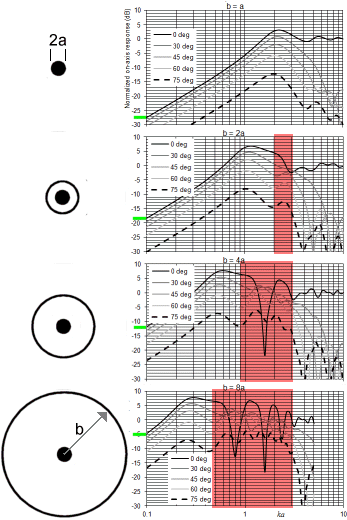
This is told in many articels and studies by various researchers, eg. Tim Mellow published also openly. Referenced by eg. Rudolf Finke.
Your demolishing Scott L's screed is a true classic post. Thanks.That's not quite right. I think your mental image of the "dreaded considerable front-to-back cancellation" gives you much grief. Let me point out some aspects that may make you better understand why the situation is not so bad.
The amount of front-to-back cancellation IS frequency dependent (ignoring walls and boundaries for a moment)....
But how about your thoughts on walls and boundaries? As always, we see posted those textbook diagrams of circular baffles and hideous FRs. C'mon.
Elsewhere I've bellyached about designs always starting with The Five Big Boxes. Rather we should start with what means do we have to sequester or otherwise employ the rear wave, with OB being perhaps the most musical of all*. (I'm proud of my 17-foot duct which measures down to 12 Hz, and resembles Pano's garage experience - if you can hear low bass it isn't too low.)
B.
* OK, living with near-full-range ESLs for 45 years, am rather favourable to the grandeur of dipole sound on classical music, like SL, rest in peace.
Your biased opinion has been duly noted.
Now, how about actually trying ?
Do you know anybody who can properly build a bass reflex design ?
There shall be no sabotage allowed !
Best wishes for a healthy and prosperous new year !!
Pot / kettle! 😉
One reason OB devotees prefer OB bass is probably down to room modes. You can get round this using multiple subs, of course:
Multiple Subwoofer after Geddes
Another reason might possibly be reduced group delay issues compared with BRs etc.
I would like to see more comparative room measurements, to verify mode reduction. The measurements of John Reekie I posted earlier, are of unknown IR gating. Typical long gating however correlates well with how we hear ampitude/loudness of signal.
On Dipole Subwoofer Placement
Prototyping a Dipole Bass System
Other thing I would like to see is group delay and step response of dipole subs measured. This correlates with timing, accuracy of transients. With a big U-baffle (tube) dipole positioned on the floor and as typical, next to wall, dipole summation hardly happens. Or is impossible to hear and measure. Even monopole downfire woofers/subs have acoustic delay in measurements because the loudest signal comes reflected from wall-floor-corner (like back-loaded horn)
Obviously a dipole bass doesn't benefit from "pressurizing" like sealed bass, which happens below lowest room mode. Remember that this is different from boundary reinforcement, which happens already higher in frequency, and differently with dipole/monopole.
Many have stated that they prefer the sound of sealed, IB or dipole bass radiators (over BR obviously). Perception, psychoacoustics of bass is grey territory and lowest bass specifically. It has been studied a lot but still there are many open questions. Most studies are made in concert halls or anechoid rooms which are totally different from domestic rooms.
http://www.davidgriesinger.com/
Tapio Lokki - Google Scholar -sitaatit
Aalto Acoustics Lab | Aalto University
https://www.princeton.edu/3D3A/
https://www.york.ac.uk/electronic-e...nd-acoustics/spatial-audio-virtual-acoustics/
On Dipole Subwoofer Placement
Prototyping a Dipole Bass System
Other thing I would like to see is group delay and step response of dipole subs measured. This correlates with timing, accuracy of transients. With a big U-baffle (tube) dipole positioned on the floor and as typical, next to wall, dipole summation hardly happens. Or is impossible to hear and measure. Even monopole downfire woofers/subs have acoustic delay in measurements because the loudest signal comes reflected from wall-floor-corner (like back-loaded horn)
Obviously a dipole bass doesn't benefit from "pressurizing" like sealed bass, which happens below lowest room mode. Remember that this is different from boundary reinforcement, which happens already higher in frequency, and differently with dipole/monopole.
Many have stated that they prefer the sound of sealed, IB or dipole bass radiators (over BR obviously). Perception, psychoacoustics of bass is grey territory and lowest bass specifically. It has been studied a lot but still there are many open questions. Most studies are made in concert halls or anechoid rooms which are totally different from domestic rooms.
http://www.davidgriesinger.com/
Tapio Lokki - Google Scholar -sitaatit
Aalto Acoustics Lab | Aalto University
https://www.princeton.edu/3D3A/
https://www.york.ac.uk/electronic-e...nd-acoustics/spatial-audio-virtual-acoustics/
Last edited:
Many good points, again.Perception, psychoacoustics of bass is grey territory and lowest bass specifically. It has been studied a lot but still there are many open questions.
We need to be cautious about relating physical and perceptual measurements. The hearing system makes all kinds of analyses and adjustments apropos echoes to produce the image you are attending to. I think my ears can much more easily perceive a piano when reproduced by a dipole than when reproduced by a "point source" box, even if nobody can produce measurements (today) that characterize the difference.*
B.
* I hope few people will bother reading a totally fatuous ignorant article by John Watkinson linked in an earlier post. It is an example of an engineer (who seems to know nothing about perception) who thinks he understands hearing by inventing in his mind what he fancies as logically necessary first principles.... complete with his fantasy version of hearing in primitive human life.
Last edited:
Late Dr. Linkwitz tried to study bass at his home listening room, but sadly he couldn't get any conlusions from his various measurements. His room is also unique, not many of us have similar shape and construction.
CM-LX521
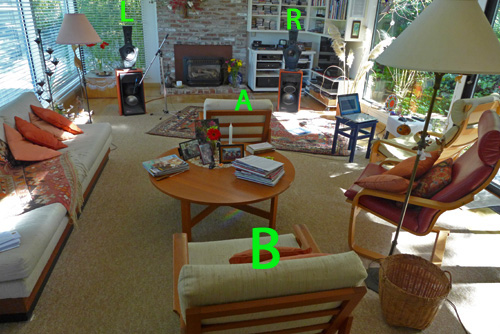
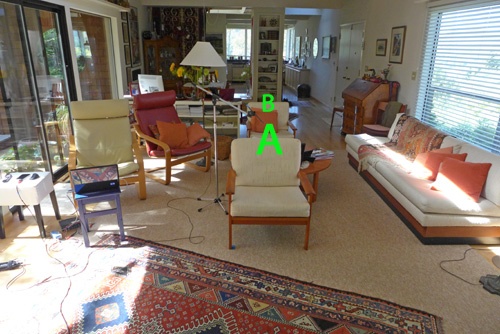
His widow Eike and Frank Brenner arrange open house listening and discussion events there (next Jan. 19th), I would like to visit Corte Madera later this year if we fly to san Francisco.
CM-LX521


His widow Eike and Frank Brenner arrange open house listening and discussion events there (next Jan. 19th), I would like to visit Corte Madera later this year if we fly to san Francisco.
Last edited:
Your demolishing Scott L's screed is a true classic post. Thanks.
But how about your thoughts on walls and boundaries? As always, we see posted those textbook diagrams of circular baffles and hideous FRs. C'mon.
Elsewhere I've bellyached about designs always starting with The Five Big Boxes. Rather we should start with what means do we have to sequester or otherwise employ the rear wave, with OB being perhaps the most musical of all*. (I'm proud of my 17-foot duct which measures down to 12 Hz, and resembles Pano's garage experience - if you can hear low bass it isn't too low.)
B.
* OK, living with near-full-range ESLs for 45 years, am rather favourable to the grandeur of dipole sound on classical music, like SL, rest in peace.
In a simple open baffle, the roll-off occurs at 6db/oct, set by the average width of the baffle. Below driver resonance, the roll-off increases to 18db/octave. Look it up. Thus, we can conclude that 18db/oct below the passband is acceptable for superior transient response of an open baffle but it's poo-poo'ed in a QB3 bass reflex.
My opinion is that OB baffle bass is erroneously touted as superior, while it really isn't. It's just a different way of doing things, with all the associated compromises that any type of bass systems has: compromises, but of a different nature.
Consider this, if OB bass was all that great, there would be a far greater number of commercial manufacturers using this scheme. But there aren't.
Scott, you really do need owe it to yourself to drive over to hill country the next time you're in Houston. I've heard many of John's OB designs, single 12, dual 15s, single 18, double 18. All have clean, low bass. Many have gotten "best bass I've ever heard" comments from listeners. Most OB systems are truly bass shy, John's are not.
Of course you might still prefer sealed box bass, a lot of people do. OB bass can be deceptive, loud without the ringing and slam that we're used to. That's great for natural recordings, but doesn't have the punch that people crave with rock, reggae and other amplified music. The sort of bass that is an artifact of PA sound systems and has become part of the music.
As a reference, a few months ago I put together an OB system in the garage with a couple of 21" woofers that I got from John. In a U frame they play flat down into the 20s with no EQ needed. They never sounded loud at all, even tho they measured loud. On first firing them up my wife came out to the garage to ask "why are all the dishes in the kitchen rattling?" That surprised me, because it just didn't sound loud to me. Clean and deep - yes. Loud, no.
So take the ride over to John's. His OB designs might not lure you away from big sealed boxes, but I'm sure they'll demonstrate that OB bass can be clean, balanced and authoritative.
Scott, I agree, a properly implemented Sealed bass system can be really accurate - enjoyable. When small (small being relative of course) foot print speakers are required by a customer, 90% of the time that is what I design them. WAF and other practical factors support (force may be a better word) going the sealed way.
One observation I have made... so many people are so used to exaggerated mid and upper bass (60-100 Hz ringing) they have encountered during their lifetimes, that is what they have learned to favor. Most live music events are amplified, so that has evolved into the "new" standard. Sad....
Sealed seems to breach the gap between what an excellent large OB can do and the usually highly distorted (ringing) presentation of most ported systems.
Getting back to the OB - Cardioid short circuit reality.... I think of the old aviation bromide: Given enough horsepower, even a barn door can fly! Kinda what's going on with OB - Cardioid bass systems.
Gentlemen: I appreciate the kind words. A U-shaped enclosure is something of an interest for me. Is the rear/open portion handled in a similar fashion as the Hartley "Boffle"" ? Please see the attached pic for an interesting way of doing things. It's called a UB-151 subwoofer.
Attachments
https://www.diyaudio.com/forums/mul...b151-modular-baffle-design-2.html#post4322866
He promised to show measurements in a bigger room, but then the thread ends... Subs/woofers are deep in corners with walls that look like concrete.
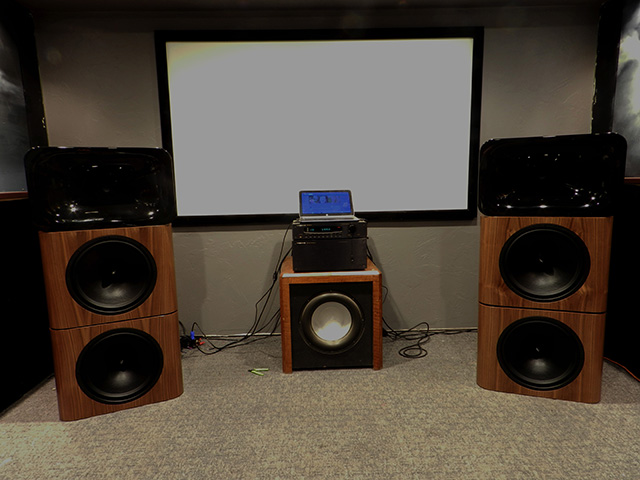
He promised to show measurements in a bigger room, but then the thread ends... Subs/woofers are deep in corners with walls that look like concrete.

Last edited:
Here interesting studies of dipole vs. monopole bass in a room, by Elias Pekonen
Elias Pekonen Home Page - Dipole Bass vs Monopole Bass
Pekonen uses ERB wavelet analysis and in his installation dipole sub outperformed monopole. Results are difficult to evaluate, because they are so unique.

"Summaring Remarks
The information in the real life music signal is composed by signal modulations. Without the modulation signal has no information, it would not be music.
A reproduction system providing more accourate transmission of the signal modulations is to be considered a better system for music reproduction.
It has been shown with modulated ERB wavelet and modulated constant Q wavelet that dipole bass reproduces the modulation better than monopole bass.
Thus in the bass range a dipole loudspeaker is better suited for music reproduction in a small room acoustic space than a monopole loudspeaker."
Elias Pekonen Home Page - Dipole Bass vs Monopole Bass
Pekonen uses ERB wavelet analysis and in his installation dipole sub outperformed monopole. Results are difficult to evaluate, because they are so unique.
"Summaring Remarks
The information in the real life music signal is composed by signal modulations. Without the modulation signal has no information, it would not be music.
A reproduction system providing more accourate transmission of the signal modulations is to be considered a better system for music reproduction.
It has been shown with modulated ERB wavelet and modulated constant Q wavelet that dipole bass reproduces the modulation better than monopole bass.
Thus in the bass range a dipole loudspeaker is better suited for music reproduction in a small room acoustic space than a monopole loudspeaker."
To me that just looks like a box with no back. I suppose that's technically a U baffle, but it's not what comes to mind when I hear the term.Is the rear/open portion handled in a similar fashion as the Hartley "Boffle"" ?
Gary Pimm in Oregon uses a similar shape for his midrange. But Gary uses carefully chosen stuffing inside to attenuate the back wave and create a cardioid pattern
I tend to think of (and build) a U baffle as a flat baffle with short wings and little or no top. The surface area of both wings is less than that of the baffle. The bottom is often the floor. As we know, the longer you make the wings, the more likely are cavity resonances. Those aren't something you want in your OB. Cavity resonances can be avoided in several easy ways.
- Keep the wings short
- Flare the wings out
- Make the wings asymmetrical
- Taper one of the wings top to bottom
John can fill in the details.
That's what my U-frames are. Acts as a dipole at low frequencies. No disadvantages to a top as far as I can see?To me that just looks like a box with no back. I suppose that's technically a U baffle, but it's not what comes to mind when I hear the term.
- Home
- Loudspeakers
- Multi-Way
- In Pursuit of a 20-20k Dipole Loudspeaker
